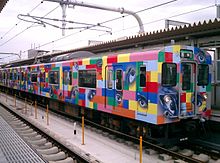Tadanori Yokoo
Tadanori Yokoo | |
|---|---|
横尾 忠則 | |
| Born | June 27, 1936 Nishiwaki, Hyōgo, Japan |
| Occupation | Graphic designer |
Tadanori Yokoo (横尾 忠則, Yokoo Tadanori, born 27 June 1936) is a Japanese graphic designer, illustrator, printmaker and painter.
Career


Tadanori Yokoo, born in Nishiwaki, Hyōgo Prefecture, Japan, in 1936, is one of Japan's most successful and internationally recognized graphic designers and artists. He began his career as a stage designer for avant garde theatre in Tokyo. His early work shows the influence of the New York-based Push Pin Studio (Milton Glaser and Seymour Chwast in particular), but Yokoo cites filmmaker Akira Kurosawa and writer Yukio Mishima as two of his most formative influences.
In the late 1960s he became interested in mysticism and psychedelia, deepened by travels in India. Because his work was so attuned to 1960s pop culture, he has often been (unfairly) described as the "Japanese Andy Warhol" or likened to psychedelic poster artist Peter Max, but Yokoo's complex and multi-layered imagery is intensely autobiographical and entirely original.
By the late 60s he had achieved international recognition for his work and was included in the 1968 "Word & Image" exhibition at the Museum of Modern Art in New York. Four years later MoMA mounted a solo exhibition of his graphic work organized by Mildred Constantine.[1] Yokoo collaborated extensively with Shūji Terayama and his theater Tenjō Sajiki. He starred as a protagonist in Nagisa Oshima's film Diary of a Shinjuku Thief.


In 1968 Yukio Mishima claimed,
Tadanori Yokoo's works reveal all of the unbearable things which we Japanese have inside ourselves and they make people angry and frightened. He makes explosions with the frightening resemblance which lies between the vulgarity of billboards advertising variety shows during festivals at the shrine devoted to the war dead and the red containers of Coca Cola in American Pop Art, things which are in us but which we do not want to see.[2]
In 1981 he unexpectedly "retired" from commercial work and took up painting after seeing a Picasso retrospective at the Museum of Modern Art (New York). His career as a fine artist continues to this day with exhibitions of his paintings every year. Alongside this, he remains fully engaged and prolific as a graphic designer.
See also
References
- ^ Heller, Steven "Mildred Constantine, 95, MoMA Curator, Is Dead", The New York Times, December 16, 2008.
- ^ Namba, Hideo. "Breaking Out of the Prison of the Ego: The Paintings of Tadanori Yokoo 1966-1996." Trans. Stanley N. Anderson. From Tadanori Yokoo. Tokyo: Heibonsha, 1996.
